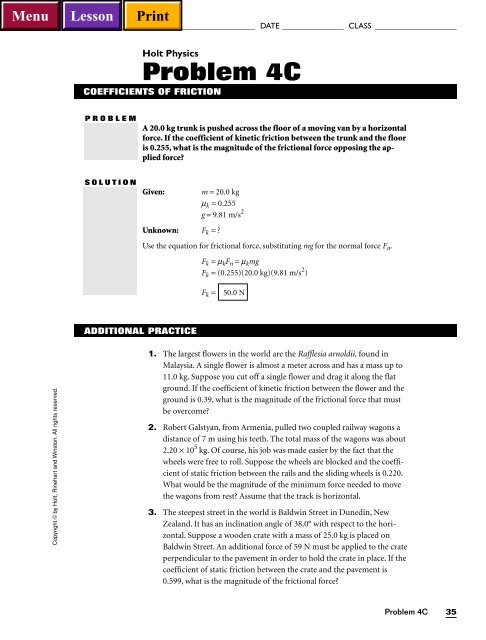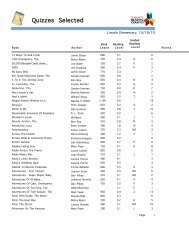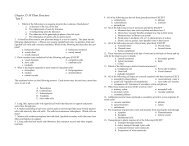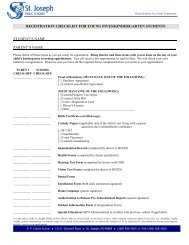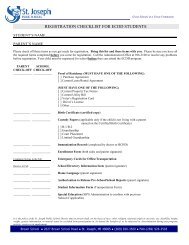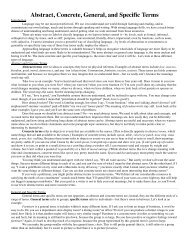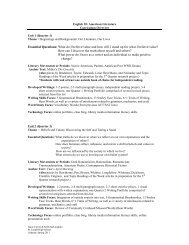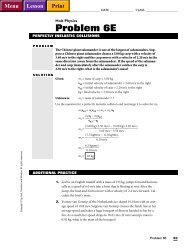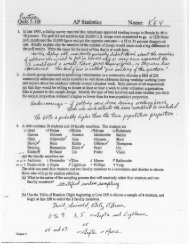Problem 4C
Problem 4C
Problem 4C
Create successful ePaper yourself
Turn your PDF publications into a flip-book with our unique Google optimized e-Paper software.
Copyright © by Holt, Rinehart and Winston. All rights reserved.<br />
NAME ______________________________________ DATE _______________ CLASS ____________________<br />
Holt Physics<br />
<strong>Problem</strong> <strong>4C</strong><br />
COEFFICIENTS OF FRICTION<br />
PROBLEM<br />
SOLUTION<br />
A 20.0 kg trunk is pushed across the floor of a moving van by a horizontal<br />
force. If the coefficient of kinetic friction between the trunk and the floor<br />
is 0.255, what is the magnitude of the frictional force opposing the applied<br />
force?<br />
Given: m = 20.0 kg<br />
m k = 0.255<br />
g = 9.81 m/s 2<br />
Unknown: F k = ?<br />
ADDITIONAL PRACTICE<br />
Use the equation for frictional force, substituting mg for the normal force F n.<br />
F k = m kF n = m kmg<br />
F k = (0.255)(20.0 kg)(9.81 m/s 2 )<br />
F k = 50.0 N<br />
1. The largest flowers in the world are the Rafflesia arnoldii, found in<br />
Malaysia. A single flower is almost a meter across and has a mass up to<br />
11.0 kg. Suppose you cut off a single flower and drag it along the flat<br />
ground. If the coefficient of kinetic friction between the flower and the<br />
ground is 0.39, what is the magnitude of the frictional force that must<br />
be overcome?<br />
2. Robert Galstyan, from Armenia, pulled two coupled railway wagons a<br />
distance of 7 m using his teeth. The total mass of the wagons was about<br />
2.20 × 10 5 kg. Of course, his job was made easier by the fact that the<br />
wheels were free to roll. Suppose the wheels are blocked and the coefficient<br />
of static friction between the rails and the sliding wheels is 0.220.<br />
What would be the magnitude of the minimum force needed to move<br />
the wagons from rest? Assume that the track is horizontal.<br />
3. The steepest street in the world is Baldwin Street in Dunedin, New<br />
Zealand. It has an inclination angle of 38.0° with respect to the horizontal.<br />
Suppose a wooden crate with a mass of 25.0 kg is placed on<br />
Baldwin Street. An additional force of 59 N must be applied to the crate<br />
perpendicular to the pavement in order to hold the crate in place. If the<br />
coefficient of static friction between the crate and the pavement is<br />
0.599, what is the magnitude of the frictional force?<br />
<strong>Problem</strong> <strong>4C</strong> 35
NAME ______________________________________ DATE _______________ CLASS ____________________<br />
36<br />
4. Now imagine that a child rides a wagon down Baldwin Street. In order<br />
to keep from moving too fast, the child has secured the wheels of the<br />
wagon so that they do not turn. The wagon and child then slide down<br />
the hill at a constant velocity. What is the coefficient of kinetic friction<br />
between the tires of the wagon and the pavement?<br />
5. The steepest railroad track that allows trains to move using their own<br />
locomotion and the friction between their wheels and the track is located<br />
in France. The track makes an angle of 5.2° with the horizontal.<br />
Suppose the rails become greasy and the train slides down the track<br />
even though the wheels are locked and held in place with blocks. If the<br />
train slides down the tracks with a constant velocity, what is the coefficient<br />
of kinetic friction between the wheels and track?<br />
6. Walter Arfeuille of Belgium lifted a 281.5 kg load off the ground using<br />
his teeth. Suppose Arfeuille can hold just three times that mass on a<br />
30.0° slope using the same force. What is the coefficient of static friction<br />
between the load and the slope?<br />
7. A blue whale with a mass of 1.90 × 10 5 kg was caught in 1947. What is<br />
the magnitude of the minimum force needed to move the whale along<br />
a horizontal ramp if the coefficient of static friction between the ramp’s<br />
surface and the whale is 0.460?<br />
8. Until 1979, the world’s easiest driving test was administered in Egypt.<br />
To pass the test, one needed only to drive about 6 m forward, stop, and<br />
drive the same distance in reverse. Suppose that at the end of the 6 m<br />
the car’s brakes are suddenly applied and the car slides to a stop. If the<br />
force required to stop the car is 6.0 × 10 3 N and the coefficient of kinetic<br />
friction between the tires and pavement is 0.77, what is the magnitude<br />
of the car’s normal force? What is the car’s mass?<br />
9. The heaviest train ever pulled by a single engine was over 2 km long.<br />
Suppose a force of 1.13 × 10 8 N is needed to overcome static friction in<br />
the train’s wheels. If the coefficient of static friction is 0.741, what is the<br />
train’s mass?<br />
10. In 1994, a 3.00 × 10 3 kg pancake was cooked and flipped in Manchester,<br />
England. If the pancake is placed on a surface that is inclined 31.0° with<br />
respect to the horizontal, what must the coefficient of kinetic friction<br />
be in order for the pancake to slide down the surface with a constant<br />
velocity? What would be the magnitude of the frictional force acting on<br />
the pancake?<br />
Holt Physics <strong>Problem</strong> Workbook<br />
Copyright © by Holt, Rinehart and Winston. All rights reserved.
II<br />
Additional Practice <strong>4C</strong><br />
Givens Solutions<br />
II Ch. 4–6<br />
1. m = 11.0 kg<br />
mk = 0.39<br />
g = 9.81 m/s 2<br />
2. m = 2.20 × 10 5 kg<br />
ms = 0.220<br />
g = 9.81 m/s 2<br />
3. m = 25.0 kg<br />
Fapplied = 59.0 N<br />
q = 38.0°<br />
ms = 0.599<br />
g = 9.81 m/s 2<br />
4. q = 38.0°<br />
g = 9.81 m/s 2<br />
5. q = 5.2°<br />
g = 9.81 m/s 2<br />
F k = m kF n = m kmg<br />
F s,max = m sF n = m smg<br />
Holt Physics Solution Manual<br />
F k = (0.39) (11.0 kg)(9.81 m/s 2 ) = 42.1 N<br />
F s,max = (0.220)(2.20 × 10 5 kg)(9.91 m/s 2 ) = 4.75 × 10 5 N<br />
F s,max = m sF m<br />
F n = mg(cos q) + F applied<br />
F s,max = m s[mg(cos q) = F applied] = (0.599)[(25.0 kg)(9.81 m/s 2 )(cos 38.0°+59.0 N]<br />
F s,max = (0.599)(193 N + 59 N) = (0.599)(252 N) =<br />
Alternatively,<br />
F net = mg(sin q) − F s,max = 0<br />
151 N<br />
F s,max = mg(sin q) = (25.0 kg)(9.81 m/s 2 )(sin 38.0°) = 151 N<br />
Fnet = mg(sin q) − Fk = 0<br />
Fk = mkFn = mkmg(cos q)<br />
mkmg(cos q) = mg(sin q)<br />
sin<br />
q<br />
mk = ⎯⎯ = tan q = tan 38.0°<br />
cos<br />
q<br />
mk = 0.781<br />
Fnet = mg(sin q) − Fk = 0<br />
Fk = mkFn = mkmg(cos q)<br />
mkmg(cos q) = mg(sin q)<br />
sin<br />
q<br />
mk = ⎯⎯ = tan q = tan 5.2°<br />
cos<br />
q<br />
mk = 0.091<br />
Copyright © by Holt, Rinehart and Winston. All rights reserved.
Copyright © by Holt, Rinehart and Winston. All rights reserved.<br />
Givens Solutions<br />
6. m = 281.5 kg<br />
q = 30.0°<br />
7. m = 1.90 × 10 5 kg<br />
ms = 0.460<br />
g = 9.81 m/s 2<br />
8. Fapplied = 6.0 × 10 3 N<br />
mk = 0.77<br />
g = 9.81 m/s 2<br />
9. Fapplied = 1.13 × 10 8 N<br />
ms = 0.741<br />
10. m = 3.00 × 10 3 kg<br />
q = 31.0°<br />
g = 9.81 m/s 2<br />
F net = 3mg(sin q) − m s(3mg)(cos q) − F applied = 0<br />
F applied = mg<br />
3mg(sin q) − mg 3(sin q) − 1.00<br />
ms = ⎯⎯ = ⎯⎯ =<br />
3mg(cos q) 3(cos q)<br />
1.<br />
50<br />
− 1.00<br />
0.<br />
50<br />
ms = ⎯ ⎯ = ⎯ ⎯<br />
(3)<br />
( cos30.0°)<br />
(3)(cos<br />
30.0°)<br />
m s = 0.19<br />
F net = F applied − F k = 0<br />
F k = m kF n = m kmg<br />
F applied = m kmg = (0.460)(1.90 × 10 5 kg)(9.81 m/s 2 )<br />
F applied = 8.57 × 10 5 N<br />
F net = F applied − F k = 0<br />
F k = m kF n<br />
Fn = ⎯ Fapplied ⎯ = ⎯<br />
mk<br />
6.0 × 10<br />
0.77<br />
3 N<br />
⎯ =<br />
Fn = mg<br />
m = ⎯ Fn<br />
⎯ = ⎯<br />
g<br />
7<br />
3<br />
.8 × 10<br />
N<br />
⎯ 2 = 8.0 × 10<br />
9.81<br />
m/<br />
s<br />
2 7.8 × 10<br />
kg<br />
3 N<br />
F net = F applied − F s,max = 0<br />
Fs,max = msFn = msmg m = ⎯ F 8<br />
applied<br />
1.<br />
13<br />
× 10<br />
N<br />
⎯ = ⎯<br />
msg<br />
(0. 741)(<br />
9.81<br />
m/s<br />
2 ⎯ = 1.55 × 10 2 kg<br />
F net = mg(sin q) − F k = 0<br />
F k = m kF n = m kmg(cos q)<br />
m kmg(cos q) = mg(sin q)<br />
sin<br />
q<br />
mk = ⎯⎯ = tan q = tan 31.0°<br />
cos<br />
q<br />
mk = 0.601<br />
F k = m kmg(cos q) = (0.601)(3.00 × 10 3 kg)(9.81 m/s 2 )(cos 31.0°)<br />
F k =<br />
1.52 × 10 4 N<br />
Alternatively,<br />
(3)(sin 30.0°) − 1.00<br />
⎯⎯⎯<br />
(3)(cos 30.0°)<br />
F k = mg(sin q) = (3.00 × 10 3 kg)(9.81 m/s 2 )(sin 31.0°) = 1.52 × 10 4 N<br />
Section Two — <strong>Problem</strong> Workbook Solutions II Ch. 4–7<br />
II


